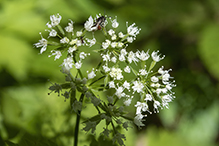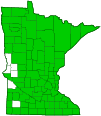aniseroot
(Osmorhiza longistylis)
Conservation • Wetland • Description • Habitat • Ecology • Use • Distribution • Taxonomy
Description |
||
Aniseroot is a common woodland wildflower. It occurs in the United States from Maine and Georgia west to Montana and New Mexico, and in adjacent Canadian provinces. It is common in Minnesota. It is found in dense to open, bottomland and upland woodlands, on the slopes of ravines, and on streambanks. It grows under dappled sunlight to moderate shade in moist to moderately moist loamy soil. It grows in high quality sites and does not tolerate Aniseroot is an erect, perennial, herbaceous forb that rises from a cluster of tuberous-thickened roots. It can be 12″ to 60″ (30 to 150 cm) tall but in Minnesota it is usually no more than 30″ (76 cm) in height. The roots are spindle-shaped and fleshy, and tend to be vertically oriented. They break with a snap and have a strong, sweet, anise-like fragrance. The stems are erect or curving up from the base (ascending) and may be branched or unbranched. They are usually sparsely to densely covered with long, soft, spreading, or shaggy hairs. Sometimes they are hairless. The main leaves are alternate, 1½″ to 10″ (4 to 25 cm) long, and broadly triangular egg-shaped in outline. They are on 2″ to 6″ (5 to 15 cm) long leaf stalks (petioles). The base of the petiole surrounds (sheaths) the stem and is not inflated or is only slightly inflated. The leaf blade is two or three times divided. It is divided into three primary leaflets (ternate); each primary leaflet is again divided into three secondary leaflets; and the secondary leaflets may be divided, lobed, or undivided. The secondary leaflet is egg-shaped to oblong lance-shaped, sharply pointed at the tip, 1½″ to 4″ (4 to 10 cm) long, and ¾″ to 2″ (2 to 5 cm) wide. The upper and lower surfaces may be sparsely covered with small, coarse, stiff hairs, especially along the veins, or they may be almost hairless. The margins are toothed. The leaves become smaller and less divided as they ascend the stem. There are often basal leaves, and one or two of these may be present at flowering time. The inflorescence is a loose, compound, umbrella-shaped cluster (umbel) at the end of the stem and each branch, and sometimes from an upper leaf axil. The umbels are dense and crowded. Each umbel is round, more or less flat-topped, and 1½″ to 3″ (4 to 8 cm) in diameter. It is at the end of a 2″ to 5″ (5 to 13 cm) long stalk (peduncle). At the base of the umbel there is a whorl (involucre) of 1 to 3 or 4 linear to lance-shaped modified leaves (bracts). The bracts are usually 3⁄16″ to ⅜″ (5 to 10 mm) long, sometimes up to ⅝″ (15 mm) long, and 1⁄32″ to 1⁄16″ (1.0 to 1.5 mm) wide. They are sharply pointed, densely hairy along the margins, and usually bent backward. This involucre is rarely absent. Each umbel has 4 to 6, sometimes 8, slender branches (rays). Each ray is ascending and ⅝″ to 2″ (1.5 to 5.0 cm) long, sometimes longer. At the end of each ray is a smaller, secondary umbel (umbellet). At the base of each umbellet there is a whorl (involucel) of 4 to 6 linear lance-shaped to egg-shaped bractlets. The bractlets are ⅛″ to ¼″ (2.5 to 6.0 mm) long and 1⁄32″ to 1⁄16″ (0.7 to 1.8 mm) wide. They are similar to the bracts and are often strongly bent backward. Each umbellet has 9 to 18 slender branches (raylets). Each raylet is ascending and 3⁄16″ to 5⁄16″ (5 to 8 mm) long, sometimes longer. At the end of each raylet is a single tiny flower. Most umbellets produce 3 to 5 or more hermaphrodite flowers, with both male and female reproductive parts, and 4 to 10 or more male (staminate) flowers. One or two umbellets in each umbel produce only staminate flowers. The central flower is usually stalkless and staminate. Each flower is 3⁄16″ to ¼″ (5 to 6 mm) in diameter and has no sepals, 5 petals, 5 stamens, and 2 styles. The corolla is showy. The petals are white, inversely lance-shaped to inversely egg-shaped, rounded and inwardly curved at the tip, with a short, sharp point at the tip. On hermaphrodite flowers they are 1⁄16″ to ⅛″ (1.5 to 2.5 mm) long, on staminate flowers they are 1⁄32″ to 1⁄16″ (1.0 to 1.5 mm) long. The stamens and styles are white. Each style, together with the disk-like expansion (styleopodium) at its base, is 1⁄16″to ⅛″ (2.0 to 3.6 mm) long. The fruit is a flattened, linear to oblong lance-shaped, slightly curved, ⅝″ to 13⁄16″ (15 to 21 mm) long seed capsule containing 2 seeds. It is green at first, with the styles at the tip persisting for a short time. It has 5 ribs with stiff, ascending, bristly hairs on the ribs. |
||
Height |
||
12″ to 30″ (30 to 76 cm) |
||
Flower Color |
||
White |
||
Similar Species |
||
Bland sweet cicely (Osmorhiza claytonii) roots have a rank odor or a weak anise-like fragrance. Hairs on the stem are longer and are straight. Crushed foliage does not have an anise-like fragrance. Umbels are loose, not crowded. There are only 4 to 7 flowers per umbellet. Flowers are smaller, ⅛″ (3 to 4 mm) in diameter. The style plus stylopodium is shorter, 1⁄64″ to 1⁄16″ (0.5 to 1.5 mm) long. Significantly fewer flowers and smaller, uncrowded umbellets combine to make the inflorescence much less showy. |
||
Habitat |
||
Moist to moderately moist. Dense to open woodlands, ravines, streambanks. Dappled sunlight to moderate shade. Loamy soil. |
||
Ecology |
||
Flowering |
||
May to June |
||
Pests and Diseases |
||
|
||
Use |
||
|
||
Distribution |
||||
|
Sources |
|||
| 7/15/2022 | ||||
Nativity |
||||
Native |
||||
Occurrence |
||||
Common |
||||
Taxonomy |
|||
| Kingdom | Plantae (Plants) | ||
| Division | Tracheophyta (Vascular Plants) | ||
| Subdivision | Spermatophytina (Seed Plants) | ||
| Class | Magnoliopsida (Dicots) | ||
Order |
Apiales (Carrots, Ivies, and Allies) | ||
Family |
Apiaceae (carrot) | ||
| Subfamily | Apioideae | ||
| Tribe | Scandiceae | ||
| Subtribe | Scandicinae | ||
Genus |
Osmorhiza (sweet cicely) | ||
Subordinate Taxa |
|||
Four varieties have been described. O. l. var. longistylis is nearly hairless, O. l. var. villicaulis is moderately hairy. None of the varieties have been widely accepted. |
|||
Osmorhiza longistylis var. brachycoma Osmorhiza longistylis var. imbarbata Osmorhiza longistylis var. longistylis Osmorhiza longistylis var. villicaulis |
|||
Synonyms |
|||
Osmorhiza aristata Washingtonia longistylis |
|||
Common Names |
|||
aniseroot long-style sweet-cicely longstyle sweetroot long-styled sweet-cicely long-styled sweetroot smooth sweet cicely smooth sweet-cicely |
|||
Glossary
Ascending
Growing upward at an angle or curving upward from the base.
Bract
Modified leaf at the base of a flower stalk, flower cluster, or inflorescence.
Bractlet
A small, often secondary bract within an inflorescence; a bract that is borne on a petiole instead of subtending it; bracteole.
Corolla
A collective name for all of the petals of a flower.
Herbaceous
Not woody. A plant without a persistent, above-ground, woody stem, with the leaves and stems usually dying back to the ground at the end of the growing season.
Involucel
A whorl of bractlets beneath a secondary flower cluster in a compound inflorescence.
Involucre
A whorl of bracts beneath or surrounding a flower, flower head, or flower cluster.
Linear
Long, straight, and narrow, with more or less parallel sides, like a blade of grass.
Peduncle
In angiosperms, the stalk of a single flower or a flower cluster; in club mosses, the stalk of a strobilus or a group of strobili.
Petiole
On plants: The stalk of a leaf blade or a compound leaf that attaches it to the stem. On ants and wasps: The constricted first one or two segments of the rear part of the body.
Ray
In the Asteraceae (aster) family: a strap-shaped flower, or the strap-shaped portion of a flower. In the Apiaceae (carrot) and Euphorbiaceae (spurge) families: a branch of an umbel.
Raylet
A branch of an umbellet.
Staminate
Referring to a flower that has a male reproductive organs (stamens) but does not have a female reproductive organ (pistil).
Ternate
Refers to leaves that are divided into three leaflets or sections.
Tuber
An underground root (as with dahlias) or stem (as with potatoes), thickened by the accumulation of reserved food (usually starch), which serves for food storage and vegetative propagation.
Umbel
A flat-topped or convex, umbrella-shaped cluster of flowers or buds arising from more or less a single point.
Umbellet
A secondary umbel in a compound umbel.
Visitor Photos |
|||||
Share your photo of this plant. |
|||||
| This button not working for you? Simply email us at info@MinnesotaSeasons.com. Attach one or more photos and, if you like, a caption. |
|||||
Greg Watson |
|||||
 |
|||||
MinnesotaSeasons.com Photos |
|||||
|
|||||

Visitor Videos |
|||
Share your video of this plant. |
|||
| This button not working for you? Simply email us at info@MinnesotaSeasons.com. Attach a video, a YouTube link, or a cloud storage link. |
|||
Other Videos |
|||
| Sweet Cicely (Osmorhiza longistylis) Mountain Gardens |
|||
About
Nov 27, 2017 |
|||
| A Secret Treat in the Forest (Osmorhiza longistylis) ReWildUniversity |
|||
About
May 26, 2021 Hi Friends! Meet "Aniseroot", an amazing wild edible, and learn about the secret treat it grants to those who know the secret! This is the perfect time of year to try it out. Look for aniseroot in upland forests, growing alongside virginia waterleaf, baneberry, goldenseal, mayapple, jack in the pulpit, etc. Note that it is in the carrot family, so be familiar with plants that look similar, especially the toxic hemlocks (which we should all learn to identify if they are in our environments). |
|||

Created: 7/16/2022
Last Updated:




